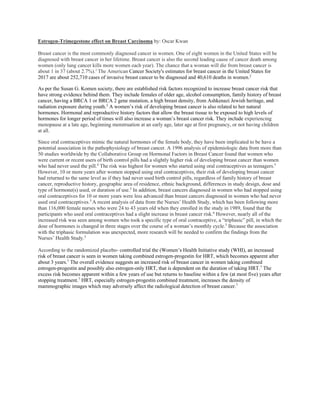
Estrogen Trimestegone Effect on Breast Carcinoma
- 1. Estrogen-Trimegestone effect on Breast Carcinoma by: Oscar Kwan Breast cancer is the most commonly diagnosed cancer in women. One of eight women in the United States will be diagnosed with breast cancer in her lifetime. Breast cancer is also the second leading cause of cancer death among women (only lung cancer kills more women each year). The chance that a woman will die from breast cancer is about 1 in 37 (about 2.7%).1 The American Cancer Society's estimates for breast cancer in the United States for 2017 are about 252,710 cases of invasive breast cancer to be diagnosed and 40,610 deaths in women.2 As per the Susan G. Komen society, there are established risk factors recognized to increase breast cancer risk that have strong evidence behind them. They include females of older age, alcohol consumption, family history of breast cancer, having a BRCA 1 or BRCA 2 gene mutation, a high breast density, from Ashkenazi Jewish heritage, and radiation exposure during youth.3 A women’s risk of developing breast cancer is also related to her natural hormones. Hormonal and reproductive history factors that allow the breast tissue to be exposed to high levels of hormones for longer period of times will also increase a woman’s breast cancer risk. They include experiencing menopause at a late age, beginning menstruation at an early age, later age at first pregnancy, or not having children at all. Since oral contraceptives mimic the natural hormones of the female body, they have been implicated to be have a potential association in the pathophysiology of breast cancer. A 1996 analysis of epidemiologic data from more than 50 studies worldwide by the Collaborative Group on Hormonal Factors in Breast Cancer found that women who were current or recent users of birth control pills had a slightly higher risk of developing breast cancer than women who had never used the pill.4 The risk was highest for women who started using oral contraceptives as teenagers.5 However, 10 or more years after women stopped using oral contraceptives, their risk of developing breast cancer had returned to the same level as if they had never used birth control pills, regardless of family history of breast cancer, reproductive history, geographic area of residence, ethnic background, differences in study design, dose and type of hormone(s) used, or duration of use.5 In addition, breast cancers diagnosed in women who had stopped using oral contraceptives for 10 or more years were less advanced than breast cancers diagnosed in women who had never used oral contraceptives.5 A recent analysis of data from the Nurses’ Health Study, which has been following more than 116,000 female nurses who were 24 to 43 years old when they enrolled in the study in 1989, found that the participants who used oral contraceptives had a slight increase in breast cancer risk.6 However, nearly all of the increased risk was seen among women who took a specific type of oral contraceptive, a “triphasic” pill, in which the dose of hormones is changed in three stages over the course of a woman’s monthly cycle.5 Because the association with the triphasic formulation was unexpected, more research will be needed to confirm the findings from the Nurses’ Health Study.5 According to the randomized placebo- controlled trial the (Women’s Health Initiative study (WHI), an increased risk of breast cancer is seen in women taking combined estrogen-progestin for HRT, which becomes apparent after about 3 years.7 The overall evidence suggests an increased risk of breast cancer in women taking combined estrogen-progestin and possibly also estrogen-only HRT, that is dependent on the duration of taking HRT.7 The excess risk becomes apparent within a few years of use but returns to baseline within a few (at most five) years after stopping treatment.7 HRT, especially estrogen-progestin combined treatment, increases the density of mammographic images which may adversely affect the radiological detection of breast cancer.7
- 2. References 1. N. (n.d.). Breast Cancer Facts :: The National Breast Cancer Foundation. Retrieved May 23, 2017, from http://www.nationalbreastcancer.org/breast-cancer-facts 2. How Common Is Breast Cancer? (n.d.). Retrieved May 23, 2017, from https://www.cancer.org/cancer/breast-cancer/about/how-common-is-breast-cancer.html 3. http://ww5.komen.org/BreastCancer/BreastCancerRiskFactorsTable.html 4. Collaborative Group on Hormonal Factors in Breast Cancer. Breast cancer and hormonal contraceptives: collaborative reanalysis of individual data on 53,297 women with breast cancer and 100,239 women without breast cancer from 54 epidemiological studies. Lancet 1996; 347(9017):1713–1727. 5. https://www.cancer.gov/about-cancer/causes-prevention/risk/hormones/oral-contraceptives-fact-sheet#q3 6. Hunter DJ, Colditz GA, Hankinson SE, et al. Oral contraceptive use and breast cancer: a prospective study of young women. Cancer Epidemiology Biomarkers and Prevention 2010; 19(10):2496–2502. 7. http://www.bfarm.de/SharedDocs/Downloads/EN/Drugs/vigilance/PSURs/csp/e-f/estradiol- trimegestone.pdf?__blob=publicationFile&v=3